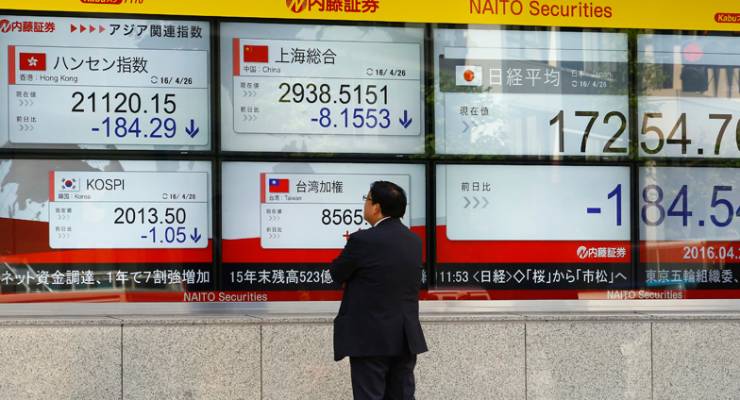
CPI drops unexpectedly. The March quarter consumer price index stunned this morning with a fall of 0.2% (from a rise of 0.4% in the December quarter), a drop that very few, if any, economists had forecast. It was the first quarterly fall since the GFC in 2008; that casued the annual rate to dip to 1.3% from 1.7% in the year to last December, and the Aussie dollar fell by three-quarters of a cent to around 76.90 US cents. Now, these are the headline numbers, but the ones the Reserve Bank focuses on — the trimmed mean and weighted median (core inflation) — also experienced big falls. The average for both fell to 0.15% from 0.55% in the December quarter, and the average annual rate fell to 1.55% from 2.0%, well below the 2% to 3% target rate. Clearly there are no cost pressures in an economy enjoying is strongest growth for three years. The Australian Bureau of Statistics said the fall in the March quarter was “broad based, with six out of the eleven CPI groups recording a fall for the quarter. The most significant fall occurred in transport (-2.5 per cent), due to automotive fuel (-10.0 per cent) falling for the third consecutive quarter.” The cost of recreation, culture, international holiday travel and accommodation and the cost of food and non-alcoholic beverages also fell, with a 11.1% slide in the cost of fruit. Rises were all seasonal for the start of the year: secondary education, medical and hospital and pharmaceutical products. The fall in the headline rate is not deflation (as some analysts will nosily claim); it is disinflation and it will be a niggle for the RBA but only a small one. — Glenn Dyer
Reality takes a bite from Apple, and tech stocks. Peak Apple, or rather Peak iPhone, or Peak Tech? That’s the big hint from this morning’s weak quarterly figures from the tech giant, and that was also the first reaction from the market — a big thumbs down, with Apple shares dropping nearly 8% to just over US$96, the first time they have been under US$100 since February. Apple’s quarterly profit fell 22.5% as revenue fell for the first time since 2003 and iPhone sales dropped for the first time ever (it was introduced in 2007) — 51.19 million iPhones were sold in the quarter (still impressive), down 16.3% from the 61.17 million sold in the March quarter of 2015; iPad sales fell 19% and Mac sales were down 9% (but sales of Apple watches rose). Apple said net profit in its fiscal second quarter totalled US$10.52 billion, compared with US$13.57 billion, in the same period a year earlier. Revenue fell 13% to US$50.55 billion from US$58 billion. Sales to Greater China, which includes Hong Kong and Taiwan, fell 26% to US$12.49 billion. In the same quarter a year earlier, Apple’s Greater China sales rose 71% — and that’s the cause of the much of the company’s problems. Sales in the Americas fell 10%. The quarterly figures didn’t include sales from Apple’s latest iPhone SE, a cheaper handset with a smaller four-inch display to replace the iPhone 5S. Twitter shares also fell after reported weak results this morning. — Glenn Dyer
And then there were two. Those nasty folk at credit rating agency Standard & Poor’s have stripped the mighty ExxonMobil of its long-held and much-desired AAA rating overnight, leaving just two US listed companies with the top rating — Microsoft and pharma group Johnson & Johnson. The cut to double A-plus follows a surge in Exxon’s debt in the past 18 months or so as oil prices have fallen (since mid-2014) and a belief that the giant will have to spend heavily to maintain production in coming years — at a time when its cash flows are under pressure from the price fall. Ratings groups have cut credit standings of a host of other companies in the oil and gas sector, while more than 50 oil and gas groups have collapsed since the start of 2015 because of the fall in prices and weakening demand. Exxon, though, is a special case. It has carried its AAA rating since 1930 (in the midst of the Great Depression and survived that) and the fall in prices and cash flow has had its debt surge from US$2 billion in 2012 to more than US$35 billion at the end of 2015. In fact, it issued a further US$12 billion in bond earlier this year. And by the way, this surge in debt makes a mockery of all those criticisms from businesses and their leaders at the rise in government debt in recent years. These companies are in a similar position to many governments (including Australia’s), and yet they blithely urge austerity on governments while being halfhearted about cost cutting on the same scale themselves. — Glenn Dyer







Crikey is committed to hosting lively discussions. Help us keep the conversation useful, interesting and welcoming. We aim to publish comments quickly in the interest of promoting robust conversation, but we’re a small team and we deploy filters to protect against legal risk. Occasionally your comment may be held up while we review, but we’re working as fast as we can to keep the conversation rolling.
The Crikey comment section is members-only content. Please subscribe to leave a comment.
The Crikey comment section is members-only content. Please login to leave a comment.